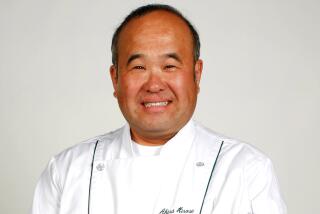Mastering the Traditional Art of Bathing at Japan’s Hot Springs : Summoning his courage and curiosity, writer finds himself in hot water at <i> onsens</i> near Tokyo.
- Share via
ODAWARA, Japan — It wasn’t the hot water that brought me to Japan last winter after an absence of 10 years, but once I was back I knew a confrontation was inevitable. A tub and I had some unfinished business to attend to, and one of us was never going to be the same.
“Perhaps the people of no other country are so fond of hot water bathing as the Japanese,” Professor Koichi Fujinami judiciously claimed in a 1936 government tourist pamphlet called “Hot Springs In Japan,” and it is those hot spring resorts, known as onsens , that are the nation’s bathing spots of choice.
Just a few days viewing of Tokyo television revealed the extent of what a more modern guide refers to as “the Japanese mania for onsens .” Everyone, from giggling couples on the Japanese version of “The Newlywed Game” to Gyn and Kyn, the wrinkled, 100-year-old twins, veterans of numerous ads, who are the darlings of the Japanese advertising world, can sooner or later be glimpsed dipping themselves into onsen waters.
I, too, 10 years earlier, had thought of giving onsens a try. In the mountain town of Takayama, roughly midway between Tokyo and Kyoto, I had checked into one, but things had gone badly almost from the start. Walking down the hall toward the water, wearing a yukata robe that barely reached my knees and slippers that didn’t quite contain my feet, I inspired peals of pointed laughter from several groups of Japanese women.
When I reached the sexually segregated bathing areas, the situation did not get much better. A boisterous group of Japanese men who obviously knew one another were laughing, talking and casually dealing with what looked to be the very complex logistics of public bathing. They were not especially happy to see me, and I suddenly felt likewise. Like Moses, forced to settle for a Mt. Pisgah view of the Promised Land he was fated never to enter, I looked around, turned around and morosely returned to my room.
When it comes to the country’s intricate web of customs and traditions, Japan can make you feel like that, like you have been thrust into the middle of a game without quite understanding the rules. Witness the business of slippers in the inn section of the onsen’s traditional rooms. You leave your shoes at the room door, wear one set of slippers to get from the door to the tatami mat floor and go barefoot on the tatami .
Trips to go to the bathroom raise the ante. You walk to the edge of the tatami , put on the first set of slippers and exchange them at the rest room door, which may or may not be in your room, for ones clearly labeled, usually in large block letters, TOILET. Late one night in Takayama, I stumbled into the bathroom without making the change and the fear that the slipper police would nab me was so strong that when I came through passport control, I half feared my infraction would appear on some computer screen and I’d be rousted and humiliated after all these years.
But that frisson of irrational fear notwithstanding, it was an older and hopefully more mature man who re-entered Japan. I was now married, with a pair of stepdaughters, one of whom was spending her junior year abroad at a Tokyo university. Not knowing my dark past where hot spring resorts were concerned, she had arranged for her mother and me to visit not one but two different onsens , both in the mountainous Hakone region in the impressive shadow of Mt. Fuji itself.
This time I vowed to be better prepared. I called on pleasant memories of time spent in a Japanese-type spa in Santa Fe, and I carefully studied the amusing pictures the Japan National Tourist Organization, ever mindful of cross-cultural difficulties, provide to show just what you do and how you do it in a Japanese bath.
As it turned out, after spending a week in Tokyo, which was more modern, more crowded and more like “Blade Runner” than I remembered, some time at a relaxing onsen , if only to escape hordes of holiday shoppers and the avalanche of cards celebrating the arrival of the Year of the Rooster, started to seem like a fine idea.
The first onsen on our list was a corporate spa owned by auto maker Isuzu, intended mainly for the company’s employees but where friends of my stepdaughter had arranged for our stay. Looking no more impressive than the clubhouse of a Midwestern golf course from the outside, it was the picture of elegant tranquillity on the inside, quiet, restful and serene in its simplicity.
The onsen itself was a stunning spot, set among graceful trees and with mist magically rising into the cold air. Equally magically, the place was deserted when I arrived. Still, ever fearful of the slipper police, I didn’t cut corners, but carefully followed the prescribed routine, soaping myself and washing off before even thinking about taking a soak. But when I dipped my foot in the pool, what resulted was the kind of scream usually heard only in samurai movies. The water was hotter than I’d ever imagined water could be.
I considered for a moment trying to adjust the temperature, but fearful of losing face and causing so much of an international incident that I would be barred forever from so much as test-driving an Isuzu, I retreated glumly to my room. Maybe onsens and I weren’t cut out for each other after all.
Still, as Scarlet used to say, tomorrow was another day, and it found us at Yoshiike, an elaborate, old-line onsen just outside the city of Odawara, with 60-plus rooms grouped around a pristine garden and two separate bathing areas, an outdoor one for women and an indoor facility for men. Though I was nothing if not discouraged, I was not ready to give up without a fight, and when the chambermaid produced an extra-large yukata that almost reached my ankles, I took that as the best of signs.
When I entered the changing room, where bathers leave every stitch of clothing in large baskets, I was struck by the wide range of attire, everything from expensive sports clothes to black leather jackets and jeans. The particular onsen was like an indoor jungle, a large irregular shaped pool with so much lush vegetation hanging over it that if a macaw had flashed by in the inevitable mist it would have looked right at home.
The half-dozen or so unclothed Japanese men in the room barely noticed me, and I slid easily into the now familiar bathing routine. I took a small plastic stool from a pile, placed it in front of a pair of faucets, sat down and filled a small plastic basin with water. Protocol further demanded that I pour several basins worth over my head and shoulders and then start soaping myself down.
Inspired by the man next to me, who was scrubbing away like there was no tomorrow, I applied myself to this routine with more than usual vigor. And as I did so it came to me for the first time that this procedure, if done with proper Japanese thoroughness, not only cleans the body but also prepares the spirit for the onsen itself, allowing you to distance yourself from everyday worries and feel that your exertions have earned the soothing nature of the waters.
After removing the soap with the prescribed basins of water over the head, I got up and moved slowly toward the pool. Astonishingly, the temperature was just right, and as I slid in up to my neck, I could literally feel my tensions slide away. It was just as Professor Fujinami had predicted so many years before, “ . . . that in a hot bath fatigue peels off as easily as the skin off a banana.”
Blissful in the pool, I was able to observe the other men, all strangers to one another, and I was struck not only by how strongly communal an experience this was, but also by how implicit and unstated that shared feeling was. While Americans would feel the need to make eye contact, grin, and say something on the order of “Hot enough for you?,” for the Japanese just being there without saying a word was all the reinforcement their sense of cultural kinship needed. “This is how we know who we are,” they seemed to say by saying nothing at all. “This is how we know we are Japanese.”
I left the pool feeling as tranquil as I ever allow myself to feel, but I didn’t realize how deep an impression the waters had made on me until I was halfway home. Trapped in the usual endless plane ride, I found myself longing not for a refreshing shower in my modern California bathroom, but for the luxurious tranquillity, both energizing and soporific, only the onsen experience can provide. It had taken me 10 years, but I had finally got the thing right after all.
GUIDEBOOK
Getting Soaked in Japan
Bath facts: Japan boasts more than 2,000 hot-spring resorts, scattered all across its mountainous terrain. Prices in establishments recommended by the Japan National Tourist Organization vary from the 10,000-yen-per-night range (just under $100) to several hundred dollars per evening. Typically that tab includes a night’s lodging and use of the resort’s facilities, including the onsen . In most cases, onsens are open only to overnight guests of the resort or inn.
Getting there: Yoshiike Ryokan is located in Odawara, one of the gateways to the Hakone region, about two hours outside of Tokyo. Its address is Yumoto 597, Hakone-machi, Ashigara-shimo-gun 250-03; from U.S. telephones 011-81-4-605-5711 or 011-81-4-605- 5716. Per person prices, including two meals, range from $150 in the off-season to $165 in high season.
The most pleasant way to reach Odawara is to take the Romance Car on the private Odakyu Railway from Shinjuku Station in Tokyo. Yoshiike is 15 minutes from the station and reachable by taxi or bus.
For more information: Write or call the Japan National Tourist Organization, 624 S. Grand Ave., Suite 1611, Los Angeles 90017; tel. (213) 623-1952. The organization’s brochure, “Japanese Hot Springs” (MG 090), lists 20 lodgings selected by JNTO for “their authentic onsen atmosphere, convenience of transportation, and availability of facilities ready to accommodate overseas guests.” Also on the same list are public bathhouses which charge from $1 to $20 for a soak.
Equally useful is JNTO’s “Japan Ryokan Guide,” which lists traditional inns, many of which function as onsens . “Your Traveling Companion” and “Economical Travel in Japan” both discuss, and even illustrate, correct hot-spring behavior.
More to Read
Sign up for The Wild
We’ll help you find the best places to hike, bike and run, as well as the perfect silent spots for meditation and yoga.
You may occasionally receive promotional content from the Los Angeles Times.







